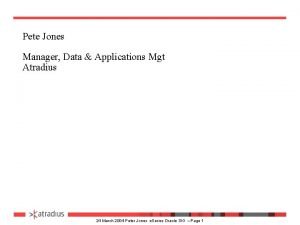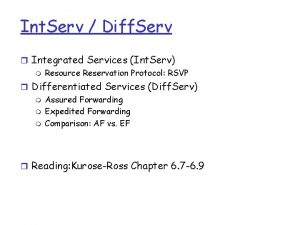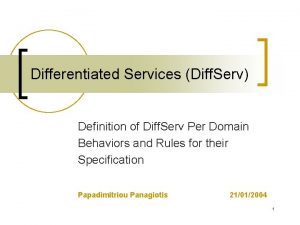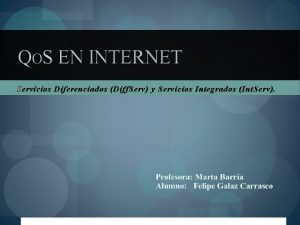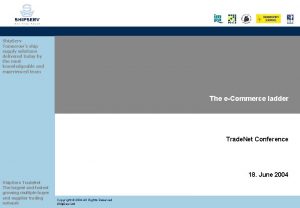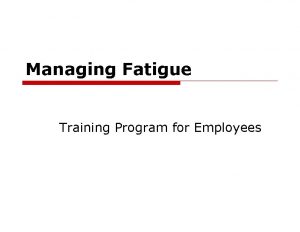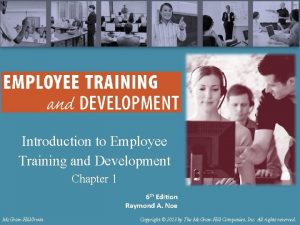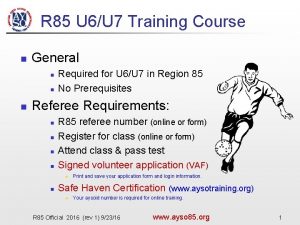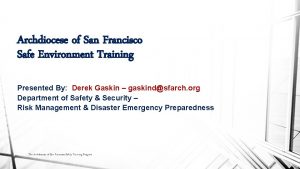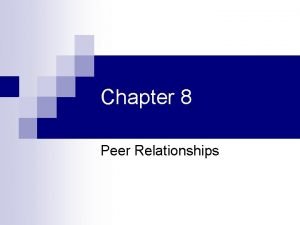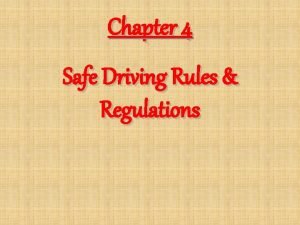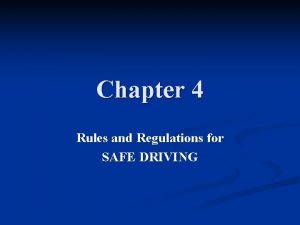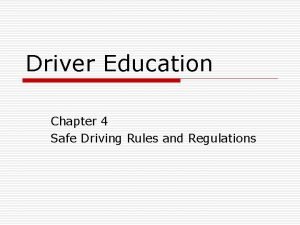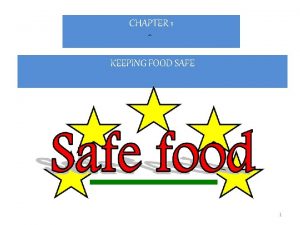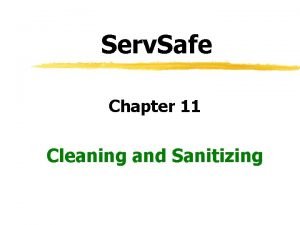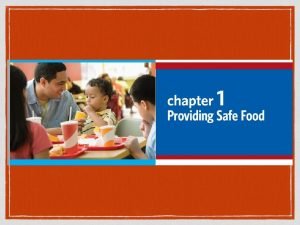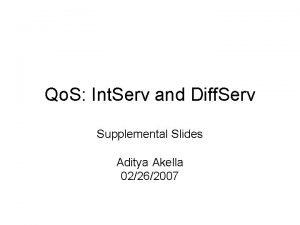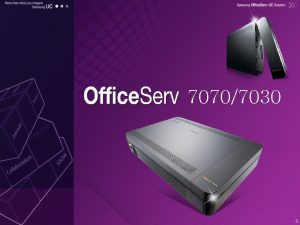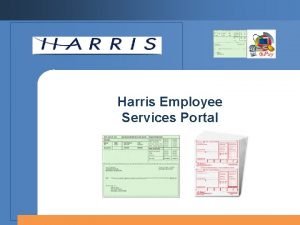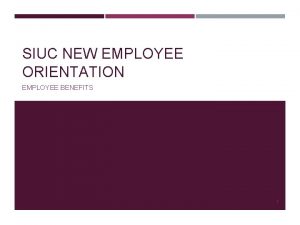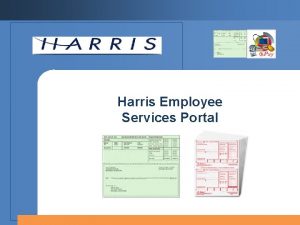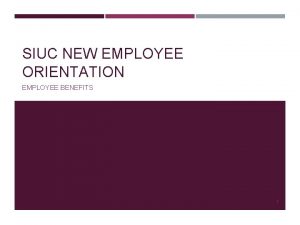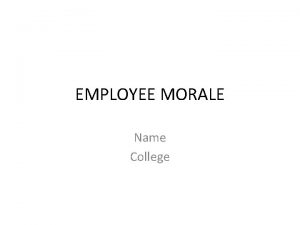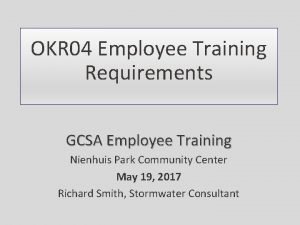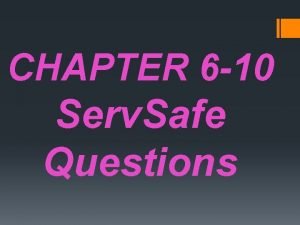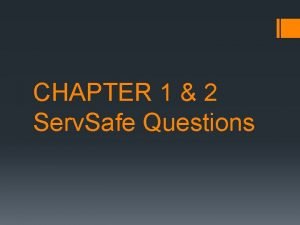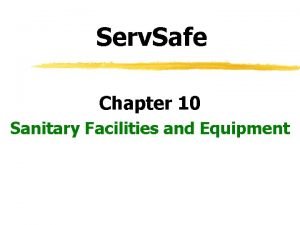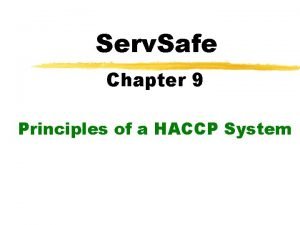Serv Safe Chapter 14 Employee FoodSafety Training Goals






































- Slides: 38

Serv. Safe Chapter 14 Employee Food-Safety Training

Goals To Focus On: z. Purpose of Food-Safety Training z. Key Elements of Effective Training z. Developing the Training Program z. Conducting the Training Session z. Food-Safety Certification

Objective After completing this chapter, you should be able to: z Assess the training needs of z employees. z Design, execute, and reinforce a training program. z Evaluate the success of a training program. z Identify when and where food-safety training should take place. z Recognize the importance of food-safety certification.

Key Terms z. Presentation z. Feedback z. Application z. Training program z. Training need z. Objective z. Demonstration z. Lecture z. Role-plays z. Job aids z“Magic apron” z. Technologybased training z. Inservices z. Evaluation

Purpose of Food-Safety Training Food-safety training provides employees with the knowledge and skills needed to handle food safely in an establishment. The final responsibility for food safety rests with the manager. Food-safety training is a positive investment.

Benefits from food-safety training include: z. Avoid the costs associated with an outbreak of foodborne illness z. Preventing the loss of reputation and revenue z. Improvement in employee morale and reduction in turnover. z. Increased customer satisfaction.

A successful training program has these essential elements: z. Clearly defined and measurable objectives z. Training that supports the objectives z. Evaluation to ensure the objectives have been achieved z. A work climate that reinforces training z. Management support

Key Elements of Effective Training Successful training involves three key elements: z. Presentation is the delivery of content to the learner through a variety of methods. One-third time spent While learners are practicing or applying the content, they must receive: z. Feedback is evaluation given to employees about their performance (positive or negative reinforcement). Feedback must be specific and immediate.

z. Application is a key element of training; practice by the learner. Two-thirds should be devoted to activities that allow class participants to apply and receive feedback.

Developing The Training Program A training program is a structured sequence of events that leads to learning. These are several steps involved in the development and delivery of an effective training program. z 1. Assess training needs. z 2. Establish learning objectives. z 3. Choose training delivery methods.

z 4. Select instructor. z 5. Choose training materials. z 6. Schedule training sessions. z 7. Select training area. z 8. Prepare trainer.

Assess Training Needs A training need is a gap between what your employees are required to know to perform their job and what they actually know. To identify food-safety training gaps you can do the following: z. Observe employee job performance. z. Question or survey employees to identify areas of weakness. z. Review past health inspection reports z. Test employee’s food-safety knowledge.

New foodhandlers will require training in the following areas: z. The importance of food safety. z. Personal hygiene: health, personal cleanliness, clothing, and hygienic practices. z. Food preparation: Potentially hazardous foods, time-temperature control, use of thermometers, proper techniques for preparation, cooking, holding, cooling, and reheating.

z. Cleaning and sanitizing procedures for the facility and equipment. z. Proper methods of handling zhazardous materials. z. Pests: harborage, pest identification, and preventive control measures. Food-safety training should be job specific.

Establish Learning Objectives An objective states what the learner will be able to do after instruction is finished. They should be clearly stated in measurable terms. Use action verbs such as operate, demonstrate, or practice.

Select Training Delivery Methods Some delivery methods are better suited to one-on-one learning and others to group learning. None are best for training at all levels. Ask yourself if the methods you have chosen allow learners to do the following: z. Talk to each other z. Reflect on the content and determine how it applies z. See the task being performed

z. Be physically active and perform the task z. Hear the instructions spoken z. Read the materials and take notes z. Reason through real-life situations The selection of the method must be based on the specific training objective being taught.

Some methods of delivery include: z. Demonstration is the process of illustrating a skill or task before another person or group. Follow these steps when conducting a demonstration: x. Preface the demonstration with an explanation of what participants should look for when the task is being demonstrated x. Emphasize the key points x. Explain how each step fits into the task sequence x. Demonstrate the skill or task slowly x. Before the participant is given an opportunity to perform ask them to explain each step x. Ask the participants to demonstrate the skill or task.

z. Lecture is a prepared oral presentation used to deliver content to a group of participants. Lectures are better received or accepted when the following techniques are used: y. Start with something interesting, a statement, observation, quotation, or question. y. Use relevant humor where appropriate. y. Use interesting and relevant examples, anecdotes, and statistics. y. Ask frequent questions y. Use frequent small group discussions and activities y. Build in review

z. Role-plays, participants enact a situation in order to try out new skills or apply what has been learned. Different types are suitable for different learning situations. They include: y. Confrontation y. Consultation y. Court techniques

z. Job aids can be used to deliver content to employees. They may include: z Worksheets z Checklists z Samples z Flowcharts z Procedural guides z Glossaries z Diagrams z Decision tables, etc. Job aids should be used on the job when tasks are complex, performed infrequently, or when the consequences of making a mistake are severe.

z One-on-one training is effective when only a few people need training. Advantages: y. It allows for the special needs of individuals y. It can take place on the job y. It enables the manager to monitor y. It allows for immediate feedback y. It allows for the opportunity to apply information

“magic apron” an ineffective type of training where employees are expected to learn proper procedures by themselves while they work on the job. A false assumption is made that employees will somehow “magically” know the job once they put on the apron.

z. Technology-Based Training use programs such as CD-ROM and CDInteractive (CD-I) offer another method of one-on-one training. The trainer is replaced by the computer or other technology. Advantages: z. Standardized delivery z. Standardized feedback z. Customizable instruction z. Increased performance practice

z. Group Training Use when several employees require food-safety training, group sessions may be more practical than one-on-one training. Advantages: z. More cost effective z. Training is more uniform z. You know precisely what have been taught

Disadvantage: z. Designed to meet the needs the overall needs of a group of employees rather than the needs of each individual. Class participation must be involved. Class participants retain 90 percent of what they say and do.

z. Inservices are ongoing training provided in short sessions. y. Typically used in the group method. y. Conducted usually monthly.

Select an Instructor The manager is often the most likely person to train staff in food safety. If not the manager the following criteria should be used to select the instructor: z. Knowledge of food-safety practices z. Understanding of the operation’s foodsafety challenges z. Demonstrated skill in human relations z. Proven ability to help others learn

Individuals who may be able to conduct food-safety training include the following: y. Immediate supervisor y. Staff trainer y. Representative of the health department y. Representative from a professional or education organization

Choose Training Materials Proper use of training materials save time, adds interest, helps participants to learn and retain information, and makes the trainer’s job easier. Follow the “Three A’s” when choosing materials: z. Accurate z. Appropriate z. Attractive

Schedule Training Sessions Developing and implementing a master training schedule can be a useful method to determine training priorities and show your commitment to training. z Both orientation and ongoing training should be included on the schedule. z Sessions should be no longer than twenty to thirty minutes. z If longer than an hour it should be broken into segments. z Should be scheduled during the slow times.

Select the Training Area Training should be done in a comfortable location. An on-site location allows for demonstrations and provides the opportunity to relate instruction to your establishment. Consider the following suggestions: z. The area should be an appropriate size z. There should be tables or desks z. Seating should be adequate and comfortable z. Seating should be arranged to encourage open discussion

z. A blackboard or flip chart z. Adequate electrical outlets for equipment z. Able to darken room for audiovisual materials z. Area free of distractions

Prepare the Trainer Training employees require excellent communication and organization skills. The following suggestions are recommended: z. Make sure you are knowledgeable in all areas of food-safety, and familiar with the details of all food-safety practices z. Prepare for the presentation z. Maintain eye contact

z. Delivery should be conversational and informal z. Use simple language z. Treat seriously all questions and comments z. Look for cues that employees are not picking up the information or they are bored and losing interest z. Keep the session short z. Keep the training as practical as possible and relate information to their jobs

Conducting the Training Session Participants want to know how the training will enable them to do their jobs faster, easier, better. Present no more than five to nine major points in a short training session. z. Keep it simple and short z. Individualize training z. Recognize employee achievement in the Training Program

z. Be creative z. Provide feedback (praise and positive feedback) z. Evaluate - judging the performance of training participants against the learning objectives. The training program is not complete until it has been evaluated. It is important because it tells you if training has provided the participants with the knowledge and skills needed to do the job.

Food-Safety Certification The National Restaurant Association and federal and state regulatory officials recommend food-safety training and certification, particularly for managers and supervisors. Certification demonstrates that a person comprehends the basic food-safety principles and recommended food-safety practices that will prevent foodborne illness.
 Strategic goals tactical goals operational goals
Strategic goals tactical goals operational goals Strategic goals tactical goals operational goals
Strategic goals tactical goals operational goals Employee attitudes and employee performance
Employee attitudes and employee performance Safe feed safe food
Safe feed safe food Safe people safe places
Safe people safe places Atradius serv net
Atradius serv net Int serv
Int serv Dtcc 011
Dtcc 011 Serv definition
Serv definition Magasabban álló rekesz
Magasabban álló rekesz Servicios diferenciados
Servicios diferenciados Apa serv alexandria
Apa serv alexandria How to use brutus password cracker
How to use brutus password cracker Ship serv
Ship serv General goals and specific goals
General goals and specific goals Examples of generic goals and product-specific goals
Examples of generic goals and product-specific goals Employee fatigue training
Employee fatigue training Introduction to employee training and development
Introduction to employee training and development Employee training methods
Employee training methods Ayso safe haven training definition
Ayso safe haven training definition Aacrao ferpa training answers
Aacrao ferpa training answers Safe training san francisco
Safe training san francisco Chapter 6 employee testing and selection ppt
Chapter 6 employee testing and selection ppt Chapter 16: employee safety and health
Chapter 16: employee safety and health Chapter 8 lesson 1 safe and healthy friendships
Chapter 8 lesson 1 safe and healthy friendships Chapter 8 healthy peer relationships
Chapter 8 healthy peer relationships Chapter 2 keeping food safe
Chapter 2 keeping food safe If a motorist’s vehicle becomes disabled he/she must?
If a motorist’s vehicle becomes disabled he/she must? Chapter 4 safe driving rules and regulations
Chapter 4 safe driving rules and regulations Chapter 4 safe driving rules and regulations
Chapter 4 safe driving rules and regulations Controlled uncontrolled and blind intersections
Controlled uncontrolled and blind intersections Keeping food safe chapter 1
Keeping food safe chapter 1 The world's constable cartoon explained
The world's constable cartoon explained Chapter 8 lesson 1 safe and healthy friendships
Chapter 8 lesson 1 safe and healthy friendships Discouraging criminal acts by threatening punishment
Discouraging criminal acts by threatening punishment Advantages and disadvantages of observation method
Advantages and disadvantages of observation method Training is expensive without training it is more expensive
Training is expensive without training it is more expensive Metode of the job training
Metode of the job training Aggression replacement training facilitator training
Aggression replacement training facilitator training





